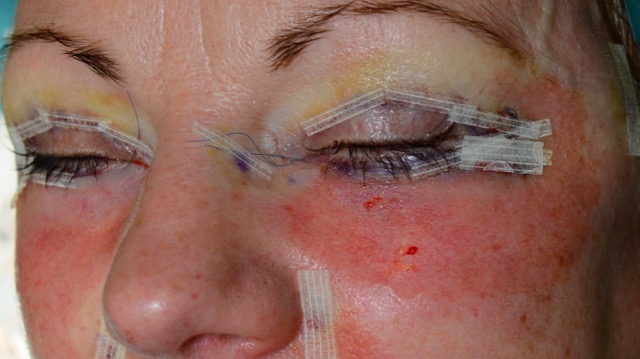[:en]
Page under construction
For a long time claims have been made of plasma eyelid lift treatments to be a substitute to blepahroplasty. As we have seen this is not the case in many instances and sometimes for several reasons. In this page we will be discussing the healing process of a blepharoplasty and compare it with the healing porcess of plasma eyelid lift in order to understand the differences. In this way the reader will have an understanding of the advantages and disadvantages of each procedure also in terms of healing process. This will help the reader build the foundations required in order to advise clients appropriately when suggesting one procedure versus the other . In this way the reader will gain a clear understanding of the pros and cons of the two types of procedures and will be able to advise their clients in the best possible way.
Eyelid surgery (blepharoplasty), like all surgery, involves a period of recovery following the procedure.
The blepharoplasty healing involves:
- Swelling.
- Pain.
- Bruising.
- The eyes may tear excessively.
- Feeling of dryness in the Eyes.
- Temporary blurred vision
- Difficulty in shutting the eyelids in certain instances.
- Overall prolonged numbness of the eyelid area.
- Over sensitivity to the light.
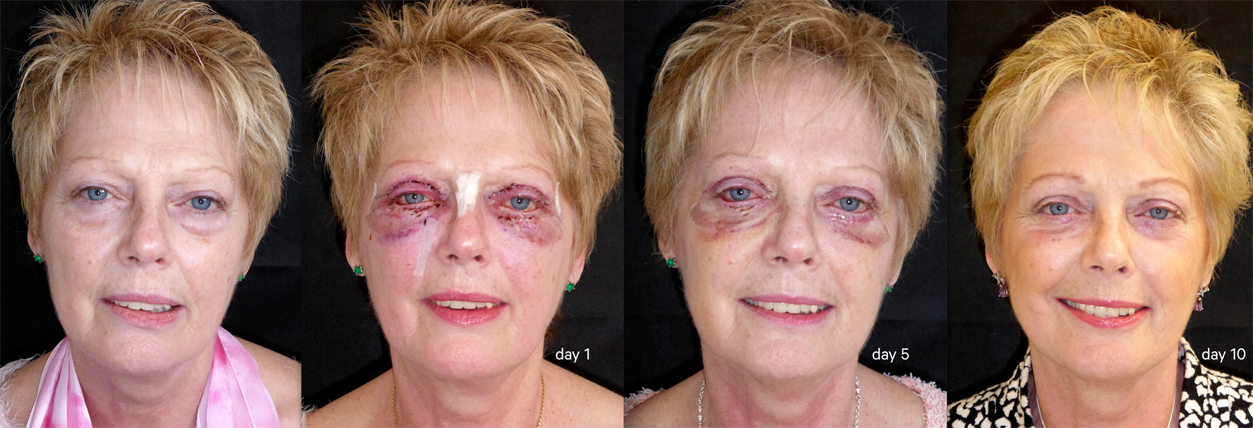
Picture showing the main stages of a blepharoplasty healing process. Initially, patients can expect redness and swelling around the incision areas. The eyes may tear excessively. Any dryness that occurs in the eye area can be alleviated by ointment that the surgeon can provide. However, patients may experience a temporary blurring of vision as a result of using the ointment. In general, temporary blurred vision is one of the common side effects of eyelid surgery. Recovery may also include temporary sensitivity to light.
In the vast majority of cases, the short-term healing is over within 10 days following the procedure. However the area will be subject to change over the several following weeks and months. The vast majority of the change will occur over the month following surgery.
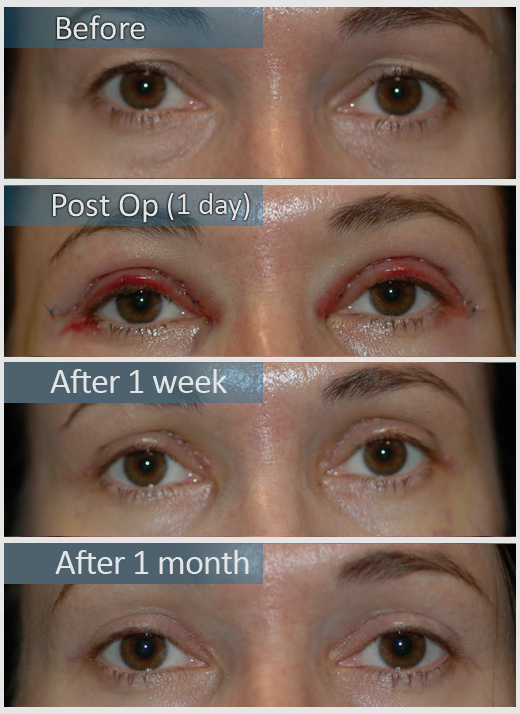
As we can see one week after the procedure is still a minor amount of swelling witch cannot be observed one month after surgery.
The swelling and bruising usually peaks on the third day after the procedure, he area starts to improve start from the third day onward.
Sutures are required during surgery and cannot be avoided. They are usually removed 7 days after the procedure. In case or absorb-able stitches the sutures will fall off on their own.
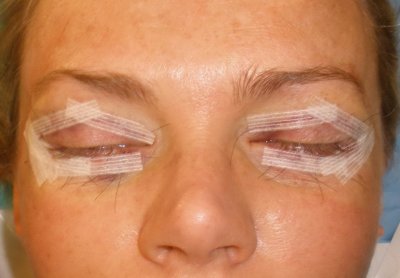
Example of what the area looks like immediately after the procedure.. The stitches are clearly visible. No swelling or bruising is present.
It is usual for patients to have bruising following blepharoplasty surgery. The bruising sustained after eyelid surgery depends on the extent of the surgery. In general, the bruising resolves fairly quickly within 7 to 10 days. The purple discoloration will turn yellow and then slowly fade away over time. In rare cases, bruising may last for up to 4 to 6 weeks following surgery.
Most bruising resolves in about a week, but residual bruising can last for several weeks depending on your rate of healing. Refrain from exercise and heavy lifting for at least a week after surgery for minimal bruising. You can also cover it up a bit with concealer after your stitches have been removed (in about a week or so).
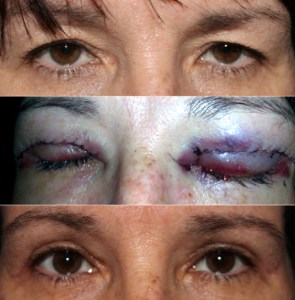
The degree and duration after blepharoplasty varies from patient to patient and technique to technique. Bruising will always go away. A bruise is the result of blood trapped in the tissues under the skin. Over time, this blood is broken down and the components reabsorbed into your system.
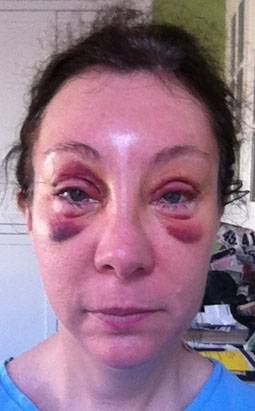
The swelling from eyelid surgery can take several months to completely resolve. The skin around the eyes is very fine. You will see changes in the swelling with improvement around your eyes for the whole first year after surgery.
can persist, depending on what was done during your procedure. If you had fat removed due to your ethnic eyes, the swelling can last for long periods of time. Elevation is the simplest thing you can do at this point. Give it time and it will diminish.
What you are experiencing is, in all likelihood, normal. Swelling that comes with reclining and goes away a while after you get up is usually not a dangerous situation, although it is always helpful to check in with your doctor to be sure.
Particularly in the head and face, when we lie down, we lose the effect that gravity provides in the upright position- gravity pulls any excess fluid down, which is why you might notice that your feet may swell during the day but be better in the morning.
The fluid that gravity causes to flow down to your trunk and to your legs gets re-distributed when you lay down, and all of your body parts, including your head, are at the same vertical level. Areas that have recently had surgery are more susceptible to swelling because the healing process may allow fluid to accumulate more in areas where the blood vessels and other drainage vessels are still regenerating.
This is the reason that we often ask patients to elevate the head of their bed at night- to keep the head and face at a higher level than the rest of the body, so gravity can help us with the swelling.
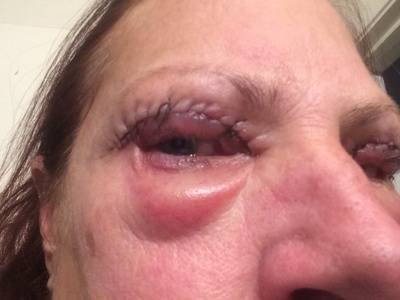
It's not unusual for patients undergoing blepharoplasty to have prolonged swelling. This swelling is often related to the magnitude of the procedure and is more common when fat pads are removed.
Most patients will note significant swelling for about two weeks following surgery. After two weeks, most patients are comfortable resuming their normal lives and going out in public. Blepharoplasty, or eyelid surgery, can create dramatic anti-aging effects for the right patient. Still, like any facial cosmetic surgery, the procedure is followed by downtime and recovery in order to allow the delicate area to heal properly. As a blepharoplasty patient, you’ll struggle to see your results in the early days of healing, thanks to the moderate to significant swelling you will likely experience. This will eventually subside, but there are steps you can take to ease your discomfort and move the process along.
Although it should be treated appropriately, swelling is certainly not an unusual reaction to surgery. In fact, it is the body’s natural response to any injury to the skin, tissue, etc. Surgery intrudes on the body and the body reacts accordingly. Swelling is a method of cushioning the affected area with fluid in order to aid recovery. As the area heals, the fluid will lessen and the swelling will go down. There are several keys to ensuring your healing process moves forward and your swelling is reduced. Most importantly, you should follow your facial plastic surgeon’s advice for a smooth recovery.
Eyelid surgery does involve the placement of incisions along the creases of the upper and/or lower eyelid in order to make the necessary changes. Patients seeking this procedure often suffer from excess loose skin on the eyelids, accumulated fat cells, and the effects of aging. Through blepharoplasty, your facial plastic surgeon will remove the excess fat and skin, reducing puffiness and sagging, and creating a more youthful appearance for the eyes. Swelling can result from this procedure as the body adjusts to the incisions and the changes your surgeon has made. Caring for the incisions and the area around the eyes, as well as yourself, can help to reduce the swelling and ensure the recovery process goes smoothly. How Can I Encourage Healing and Reduce Swelling?
The fastest way to banish swelling around the eyes is to allow your body the resources it needs to properly heal. Getting enough rest and taking time away from your daily activities is the first step to a successful recovery, so plan ahead to be away from work for at least one week, maybe two. During this time, encourage your body to heal with the following steps:
- Avoid strenuous activity and vigorous exercise until you are clear to resume them.
- Eat healthy food and drink enough water to stay hydrated. Your body will need resources to recover well.
- Pain management, especially with anti-inflammatory drugs, can keep the swelling manageable and help you rest.
- Keep your head elevated to reduce blood flow to the areas around the eyes, which can reduce swelling.
- Apply cold compresses to the surgical area, only if advised by your facial plastic surgeon.
Your facial plastic surgeon may offer additional advice and tips on how to heal quickly enough to reduce your swelling at a reasonable pace. Also remember to stay positive as you recover. Keeping your spirits up and avoiding stress can allow the body to do what is necessary to heal fully.
Swelling will begin almost right away, so you should expect to feel the pressure and some discomfort immediately after you wake up. You won’t be allowed to drive home from your surgery, so arrange for a friend or family member to bring you in and drive you home safely. Your swelling will get worse before it starts to get better, so don’t be alarmed if the area feels puffier for the first couple of days. After that, you will notice the swelling starts to recede gradually, every day a little bit more. By the end of your second week, 80 percent of your swelling will be gone. That last 20 percent can hang around for a few more weeks but should be completely gone within two to three months. If you ever have concerns about your swelling or healing process, contact your facial plastic surgeon’s office for the best advice.
If you’ve been frustrated with the signs of aging around your eyes, including sagging eyelids, puffiness, and excess skin, you may be eligible for blepharoplasty surgery. To plan your procedure, start with a consultation at The Glasgold Group,where your health, safety, and satisfaction are a top priority. A family practice, The Glasgold Group was founded over 30 years ago by Dr. Alvin Glasgold. His sons, Dr. Robert Glasgold and Dr. Mark Glasgold, carry on the family legacy as board certified Facial Plastic Surgeons in central New Jersey. Dr. Robert Glasgold offers patients expert knowledge in his specialty areas in aesthetic facial plastic surgery, especially in blepharoplasty, rhinoplasty, and total facial rejuvenation. Dr. Mark Glasgold focuses on the complete rejuvenation of the aging face, specifically facelifts, eyelid surgeries, and more. Book a consultation with the Glasgold Group, located at 31 River Road in Highland Park, New Jersey, by calling (732) 846-6540 today.
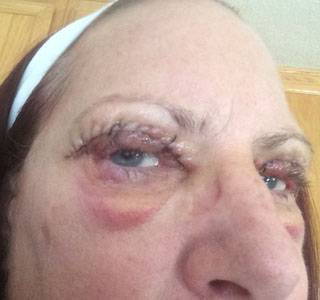
Maximum swelling is usually at about 3-5 days and goes away over a few months. You should sleep with your head elevated and cut back on salt to help the swelling.
While swelling after any surgery is of course normal, it would be best to see your doctor to make sure you have not developed an infection in the operated area. It is a bit unusual to see significant swelling in the face a week after a simple blepharoplasty.
If there is no evidence of an infection, he may recommend warm or cool compresses and elevation of the head at nighttime. You may also want to discuss with him your activity level (i.e. working out), which can worsen early postoperative swelling.
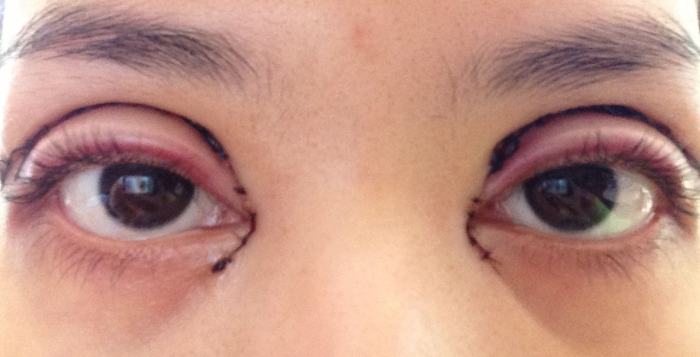
Eyelid swelling is extremely common following blepharoplasty. Following surgery, the majority of the swelling has disappeared in about a week, but small amounts may persist for up to a month. In patients who have had revisional surgery swelling may last for longer periods of time
What you are experiencing is, in all likelihood, normal. Swelling that comes with reclining and goes away a while after you get up is usually not a dangerous situation, although it is always helpful to check in with your doctor to be sure.
Particularly in the head and face, when we lie down, we lose the effect that gravity provides in the upright position- gravity pulls any excess fluid down, which is why you might notice that your feet may swell during the day but be better in the morning.
The fluid that gravity causes to flow down to your trunk and to your legs gets re-distributed when you lay down, and all of your body parts, including your head, are at the same vertical level. Areas that have recently had surgery are more susceptible to swelling because the healing process may allow fluid to accumulate more in areas where the blood vessels and other drainage vessels are still regenerating.
This is the reason that we often ask patients to elevate the head of their bed at night- to keep the head and face at a higher level than the rest of the body, so gravity can help us with the swelling.
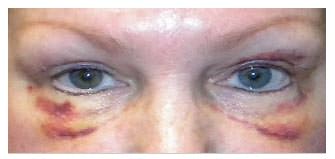
With rare exceptions, swelling caused by eyelid surgery resolves in time. Four weeks after a surgery is actually considered to be relatively soon after surgery. This means that the swelling you are experiencing will get better in time. The rare circumstances where swelling lingers can be related to surgical disruption to the eyelid lymphatics but even this type of swelling resolves eventually.
However, there other causes of fullness following eyelid surgery that are unrelated to tissue swelling. This can include fullness from tissue that can become heaped or wadded with surgery. This can be seen for example after fat transfer to the lower eyelid. You indicate that your surgeon straighten out muscle in the eyelid. Again this might heal in such a way that the eyelid contour is not even or smooth and initially is seen with tissue swelling as general fullness. These types of issues generally benefit from 6 to 12 months of healing and whatever has not fully resolved at the point may need to be addressed with revisional surgery.
Finally, ask yourself if what is concerning you is your confidence in your surgeon or the office. Sometime offices (and their doctors) don't give patients the opportunity to voice their concerns about the surgical results. The doctor or staff know that almost everything gets better in time and the goal is simply to give you time for that recovery. However, they still need to listen to your concerns. Often second opinion in this time frame are not very productive for the simple reason that what is needed is time. However, if you are truly concerned and feel that your concerns are not being addressed, a second opinion may be useful.
After upper and lower blepharoplasty surgery, the eyelids typically feel tight; accompanying soreness may be treated with analgesics. For the first couple of days following the surgery, the incisions should be treated with ointment to keep them lubricated. Cold compresses can be placed on the eyes to reduce swelling as well. Eye drops will be necessary to help keep the eyes from drying out.
In the first week after the procedure, patients should avoid any activities that may dry up the eyes, including reading, watching television, wearing contacts, and using a computer. Swelling and bruising can be minimized by keeping the head elevated as much as possible during the first few days of recovery. The doctor will remove the stitches between two and seven days after the eyelid surgery procedure. Patients may feel well enough to resume normal activities around the tenth day of recovery.
For the first couple of weeks following the surgery, dark sunglasses are recommended to protect the eyes from irritation caused by the sun and wind. Patients may notice that their eyes tire easily for the first several weeks of the recovery period; frequent naps are recommended.
Throughout the first three to four weeks after the surgery, any activities that increase blood flow to the eyes should be avoided, including bending, lifting, sporting activities, and even crying. Patients will be informed by their physicians when any type of exercise regimen can be resumed.
Recovery from eyelid surgery generally takes several weeks. Within two days to a week, the stitches will be removed. In the first week, patients will want to make sure that their eyes receive plenty of rest. The redness and swelling occurring after the blepharoplasty procedure will fade with time. Recovery will also include ensuring that any exertion that may increase blood flow to the eyes is avoided. Patients may be able to return to work approximately 10 days after the surgery.
For some, the recovery process can seem long and they may become depressed, especially in the early stages of recovery when their faces appear swollen and bruised. But after a few weeks most patients begin to notice a welcome change in their appearance. The results of eyelid surgery – eyes that look younger and more alert – remind patients why they chose to undergo the procedure in the first place.
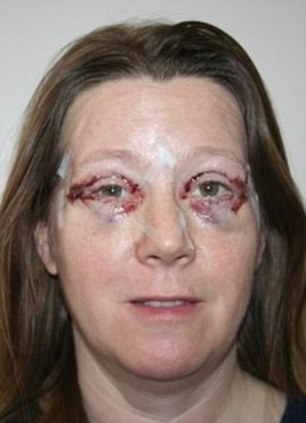
Take the eyelid tightening test – Click Here
[:es]
Pagina en construcción.
Durante mucho tiempo se han hecho reclamos de tratamientos de levantamiento de párpados con plasma para ser un sustituto de la bleoproplastia. Como hemos visto, este no es el caso en muchos casos y, a veces, por varias razones. En esta página, discutiremos el proceso de curación de una blefaroplastia y lo compararemos con el proceso de curación del levantamiento del párpado con plasma para comprender las diferencias. De esta manera, el lector comprenderá las ventajas y desventajas de cada procedimiento también en términos de proceso de curación. Esto ayudará al lector a construir los cimientos necesarios para asesorar a los clientes de manera apropiada al sugerir un procedimiento en lugar de otro. De esta manera, el lector obtendrá una comprensión clara de las ventajas y desventajas de los dos tipos de procedimientos y podrá asesorar a sus clientes de la mejor manera posible.
La cirugía de párpados (blefaroplastia), como toda cirugía, implica un período de recuperación después del procedimiento.
La curación con blefaroplastia implica:
- Hinchazón.
- Dolor
- Moretones
- Los ojos pueden desgarrarse excesivamente.
- Sensación de sequedad en los ojos..
- Visión borrosa temporal
- Dificultad para cerrar los párpados en ciertos casos.
- Entumecimiento general prolongado del área del párpado.
- Sobre sensibilidad a la luz.

Imagen que muestra las etapas principales de un proceso de curación de blefaroplastia. Inicialmente, los pacientes pueden esperar enrojecimiento e hinchazón alrededor de las áreas de incisión. Los ojos pueden desgarrarse excesivamente. Cualquier sequedad que se produzca en el área de los ojos puede aliviarse con un ungüento que el cirujano puede proporcionar. Sin embargo, los pacientes pueden experimentar una visión borrosa temporal como resultado del uso de la pomada. En general, la visión borrosa temporal es uno de los efectos secundarios comunes de la cirugía de párpados. La recuperación también puede incluir sensibilidad temporal a la luz.
En la gran mayoría de los casos, la curación a corto plazo termina dentro de los 10 días posteriores al procedimiento. Sin embargo, el área estará sujeta a cambios durante las siguientes semanas y meses. La gran mayoría del cambio se producirá durante el mes posterior a la cirugía.

Como podemos ver, una semana después del procedimiento sigue siendo una pequeña cantidad de hinchazón que no se puede observar un mes después de la cirugía.
La hinchazón y los moretones generalmente alcanzan su punto máximo en el tercer día después del procedimiento, el área comienza a mejorar a partir del tercer día.
Las suturas son necesarias durante la cirugía y no pueden evitarse. Por lo general, se retiran 7 días después del procedimiento. En el caso de puntos de sutura o absorbibles, las suturas se caerán solas.

Ejemplo de cómo se ve el área inmediatamente después del procedimiento. Los puntos son claramente visibles. No hay hinchazón o moretones.
Es habitual que los pacientes tengan hematomas después de la cirugía de blefaroplastia. Los moretones sostenidos después de la cirugía de párpados dependen de la extensión de la cirugía. En general, los moretones se resuelven con bastante rapidez en un plazo de 7 a 10 días. La decoloración púrpura se volverá amarilla y luego se desvanecerá lentamente con el tiempo. En casos raros, los moretones pueden durar de 4 a 6 semanas después de la cirugía.
La mayoría de los moretones se resuelven en aproximadamente una semana, pero los moretones residuales pueden durar varias semanas, dependiendo de su tasa de curación. Abstenerse de hacer ejercicio y levantar objetos pesados durante al menos una semana después de la cirugía para evitar moretones mínimos. También puede cubrirlo un poco con el corrector después de que le hayan quitado los puntos (en aproximadamente una semana)..

El grado y la duración después de la blefaroplastia varían de un paciente a otro y de una técnica a otra. Moretones siempre desaparecerá. Un moretón es el resultado de la sangre atrapada en los tejidos debajo de la piel. Con el tiempo, esta sangre se descompone y los componentes se reabsorben en su sistema.

La hinchazón de la cirugía de párpados puede tardar varios meses en resolverse por completo. La piel alrededor de los ojos es muy fina. Verá cambios en la hinchazón con mejoría alrededor de sus ojos durante todo el primer año después de la cirugía.
Puede persistir, dependiendo de lo que se hizo durante su procedimiento. Si le quitaron grasa debido a sus ojos étnicos, la hinchazón puede durar largos períodos de tiempo. La elevación es lo más simple que puedes hacer en este momento. Dale tiempo y disminuirá.
Lo que está experimentando es, con toda probabilidad, normal. La hinchazón que viene con la reclinación y desaparece después de levantarse no suele ser una situación peligrosa, aunque siempre es útil consultar con su médico para estar seguro.
Especialmente en la cabeza y la cara, cuando nos acostamos, perdemos el efecto que proporciona la gravedad en la posición vertical: la gravedad elimina cualquier exceso de líquido, por lo que puede notar que sus pies pueden hincharse durante el día pero estar mejor en el cuerpo. Mañana
El líquido que la gravedad hace que fluya hacia su tronco y hacia sus piernas se redistribuye cuando se recuesta, y todas las partes de su cuerpo, incluida su cabeza, están al mismo nivel vertical. Las áreas que recientemente se sometieron a una cirugía son más susceptibles a la hinchazón porque el proceso de curación puede permitir que el líquido se acumule más en áreas donde los vasos sanguíneos y otros vasos de drenaje aún se están regenerando.
Esta es la razón por la que a menudo pedimos a los pacientes que eleven la cabecera de su cama por la noche, para mantener la cabeza y la cara en un nivel más alto que el resto del cuerpo, de modo que la gravedad puede ayudarnos con la hinchazón.

No es inusual que los pacientes que se someten a una blefaroplastia presenten inflamación prolongada. Esta hinchazón a menudo está relacionada con la magnitud del procedimiento y es más común cuando se extraen las almohadillas de grasa..
La mayoría de los pacientes notarán una inflamación significativa durante aproximadamente dos semanas después de la cirugía. Después de dos semanas, la mayoría de los pacientes se sienten cómodos reanudando sus vidas normales y saliendo en público. La blefaroplastia, o cirugía de párpados, puede crear dramáticos efectos antienvejecimiento para el paciente correcto. Aún así, como en cualquier cirugía estética facial, al procedimiento le sigue el tiempo de inactividad y la recuperación para permitir que el área delicada se cure correctamente. Como paciente de blefaroplastia, tendrá dificultades para ver sus resultados en los primeros días de la curación, gracias a la inflamación moderada a significativa que probablemente experimentará. Esto eventualmente disminuirá, pero hay pasos que puede tomar para aliviar su incomodidad y hacer avanzar el proceso.
Aunque debe tratarse adecuadamente, la hinchazón no es una reacción inusual a la cirugía. De hecho, es la respuesta natural del cuerpo a cualquier lesión en la piel, el tejido, etc. La cirugía se entromete en el cuerpo y el cuerpo reacciona en consecuencia. La hinchazón es un método para amortiguar el área afectada con líquido para ayudar a la recuperación. A medida que el área se cure, el líquido disminuirá y la hinchazón disminuirá. Hay varias claves para asegurar que su proceso de curación avance y se reduzca su hinchazón. Lo más importante es que debe seguir los consejos de su cirujano plástico facial para una recuperación sin problemas.
La cirugía de párpados implica la colocación de incisiones a lo largo de las arrugas del párpado superior y / o inferior para realizar los cambios necesarios. Los pacientes que buscan este procedimiento a menudo sufren de exceso de piel suelta en los párpados, células grasas acumuladas y los efectos del envejecimiento. A través de la blefaroplastia, su cirujano plástico facial eliminará el exceso de grasa y la piel, reduciendo la hinchazón y la flacidez y creando una apariencia más juvenil para los ojos. La hinchazón puede resultar de este procedimiento a medida que el cuerpo se adapta a las incisiones y los cambios que ha realizado su cirujano. Cuidar las incisiones y el área alrededor de los ojos, así como usted mismo, puede ayudar a reducir la hinchazón y asegurar que el proceso de recuperación se realice sin problemas. ¿Cómo puedo fomentar la curación y reducir la hinchazón?
La forma más rápida de eliminar la hinchazón alrededor de los ojos es permitirle a su cuerpo los recursos que necesita para curarse adecuadamente. Descansar lo suficiente y tomarse un tiempo lejos de sus actividades diarias es el primer paso para una recuperación exitosa, por lo tanto, planifique con anticipación la ausencia del trabajo durante al menos una semana, quizás dos. Durante este tiempo, anime a su cuerpo a sanar con los siguientes pasos:
- Evite la actividad vigorosa y el ejercicio vigoroso hasta que esté claro para reanudarlos.
- Comer alimentos saludables y beber suficiente agua para mantenerse hidratado. Su cuerpo necesitará recursos para recuperarse bien.
- El control del dolor, especialmente con medicamentos antinflamatorios, puede mantener la hinchazón manejable y ayudarlo a descansar..
- Mantenga su cabeza elevada para reducir el flujo de sangre a las áreas alrededor de los ojos, lo que puede reducir la hinchazón.
- Aplique compresas frías en el área tratada, solo si lo recomienda su cirujano plástico facial.
Su cirujano plástico facial puede ofrecerle consejos adicionales y consejos sobre cómo curarse lo suficientemente rápido para reducir su hinchazón a un ritmo razonable. También recuerda mantenerte positivo mientras te recuperas. Mantener el ánimo en alto y evitar el estrés puede permitir que el cuerpo haga lo que sea necesario para sanar por completo.
La hinchazón comenzará casi de inmediato, por lo que debe esperar sentir la presión y cierta incomodidad inmediatamente después de levantarse. No se le permitirá conducir hasta su casa después de su cirugía, así que haga arreglos para que un amigo o familiar lo traiga y lo lleve a su casa de manera segura Su hinchazón empeorará antes de que empiece a mejorar, así que no se alarme si el área se siente más hinchada durante los primeros días. Después de eso, notará que la hinchazón comienza a disminuir gradualmente, cada día un poco más. Al final de la segunda semana, el 80 por ciento de su hinchazón habrá desaparecido. Ese último 20 por ciento puede quedarse por unas pocas semanas más, pero debería haber desaparecido por completo en dos o tres meses. Si alguna vez tiene inquietudes acerca de su hinchazón o proceso de curación, comuníquese con el consultorio de su cirujano plástico facial para obtener los mejores consejos.
Si se ha sentido frustrado con los signos de envejecimiento alrededor de sus ojos, incluidos los párpados caídos, la hinchazón y el exceso de piel, puede ser elegible para una cirugía de blefaroplastia. Para planificar su procedimiento, comience con una consulta en The Glasgold Group, donde su salud, seguridad y satisfacción son una prioridad absoluta. Una práctica familiar, The Glasgold Group fue fundada hace más de 30 años por el Dr. Alvin Glasgold. Sus hijos, el Dr. Robert Glasgold y el Dr. Mark Glasgold, mantienen el legado familiar como cirujanos plásticos faciales certificados por la junta en el centro de Nueva Jersey. El Dr. Robert Glasgold ofrece a los pacientes conocimientos especializados en sus áreas de especialidad en cirugía estética facial plástica, especialmente en blefaroplastia, rinoplastia y rejuvenecimiento facial total. El Dr. Mark Glasgold se enfoca en el rejuvenecimiento completo de la cara envejecida, específicamente los estiramientos faciales, las cirugías de párpados y más. Reserve una consulta con el Grupo Glasgold, ubicado en 31 River Road en Highland Park, Nueva Jersey, llamando al (732) 846-6540 hoy.

Por lo general, la hinchazón máxima es de aproximadamente 3 a 5 días y desaparece en unos pocos meses. Debes dormir con la cabeza elevada y reducir la sal para ayudar a la hinchazón.
Si bien la hinchazón después de cualquier cirugía es normal, sería mejor que consulte a su médico para asegurarse de que no haya desarrollado una infección en el área operada. Es un poco inusual ver una hinchazón significativa en la cara una semana después de una simple blefaroplastia.
Si no hay evidencia de una infección, puede recomendar compresas tibias o frías y elevación de la cabeza durante la noche. También puede discutir con él su nivel de actividad (es decir, hacer ejercicio), que puede empeorar la inflamación postoperatoria temprana.

La hinchazón de los párpados es extremadamente común después de la blefaroplastia. Después de la cirugía, la mayoría de la hinchazón ha desaparecido en aproximadamente una semana, pero pequeñas cantidades pueden persistir hasta por un mes. En pacientes que se han sometido a una cirugía de revisión, la hinchazón puede durar más tiempo
Lo que está experimentando es, con toda probabilidad, normal. La hinchazón que viene con la reclinación y desaparece un tiempo después de levantarse no suele ser una situación peligrosa, aunque siempre es útil consultar con su médico para estar seguro.
Especialmente en la cabeza y la cara, cuando nos acostamos, perdemos el efecto que proporciona la gravedad en la posición vertical: la gravedad elimina cualquier exceso de líquido, por lo que puede notar que sus pies pueden hincharse durante el día pero estar mejor en el cuerpo. Mañana.
El líquido que la gravedad hace que fluya hacia su tronco y hacia sus piernas se redistribuye cuando se recuesta, y todas las partes de su cuerpo, incluida su cabeza, están al mismo nivel vertical. Las áreas que recientemente se sometieron a una cirugía son más susceptibles a la hinchazón porque el proceso de curación puede permitir que el líquido se acumule más en áreas donde los vasos sanguíneos y otros vasos de drenaje aún se están regenerando.
Esta es la razón por la que a menudo pedimos a los pacientes que eleven la cabecera de su cama por la noche, para mantener la cabeza y la cara en un nivel más alto que el resto del cuerpo, de modo que la gravedad puede ayudarnos con la hinchazón.

Con raras excepciones, la inflamación causada por la cirugía de párpados se resuelve a tiempo. Cuatro semanas después de una cirugía se considera que es relativamente poco después de la cirugía. Esto significa que la hinchazón que está experimentando mejorará con el tiempo. Las raras circunstancias en las que la hinchazón persiste pueden estar relacionadas con la interrupción quirúrgica de los linfáticos del párpado, pero incluso este tipo de hinchazón se resuelve con el tiempo.
Sin embargo, existen otras causas de plenitud después de la cirugía de párpados que no están relacionadas con la inflamación del tejido. Esto puede incluir la plenitud del tejido que se puede acumular o rellenar con la cirugía. Esto se puede ver, por ejemplo, después de la transferencia de grasa al párpado inferior. Usted indica que su cirujano endereza el músculo en el párpado. Nuevamente, esto podría curar de tal manera que el contorno del párpado no sea uniforme y se vea inicialmente con la hinchazón del tejido como una plenitud general. Estos tipos de problemas generalmente se benefician de una curación de 6 a 12 meses y cualquier cosa que no se haya resuelto completamente en el momento tal vez deba abordarse con cirugía de revisión.
Finalmente, pregúntese si lo que le preocupa es su confianza en su cirujano o en el consultorio. En algún momento, las oficinas (y sus médicos) no les dan a los pacientes la oportunidad de expresar sus inquietudes sobre los resultados quirúrgicos. El médico o el personal saben que casi todo mejora en el tiempo y el objetivo es simplemente darle tiempo para esa recuperación. Sin embargo, todavía necesitan escuchar sus preocupaciones. A menudo, la segunda opinión en este marco de tiempo no es muy productiva por la sencilla razón de que lo que se necesita es tiempo. Sin embargo, si está realmente preocupado y siente que sus preocupaciones no están siendo abordadas, una segunda opinión puede ser útil.
Después de la cirugía de blefaroplastia superior e inferior, los párpados generalmente se sienten estirados; El dolor acompañante se puede tratar con analgésicos. Durante los primeros días posteriores a la cirugía, las incisiones deben tratarse con ungüento para mantenerlas lubricadas. También se pueden colocar compresas frías en los ojos para reducir la hinchazón. Las gotas para los ojos serán necesarias para ayudar a evitar que los ojos se sequen.
En la primera semana después del procedimiento, los pacientes deben evitar cualquier actividad que pueda secar los ojos, como leer, mirar televisión, usar contactos y usar una computadora. La inflamación y los moretones se pueden minimizar manteniendo la cabeza elevada tanto como sea posible durante los primeros días de recuperación. El médico retirará los puntos de sutura entre dos y siete días después del procedimiento de cirugía de párpados. Los pacientes pueden sentirse lo suficientemente bien como para reanudar sus actividades normales alrededor del décimo día de recuperación.
Durante las primeras semanas posteriores a la cirugía, se recomiendan gafas oscuras para proteger los ojos de la irritación causada por el sol y el viento. Los pacientes pueden notar que sus ojos se cansan fácilmente durante las primeras semanas del período de recuperación; Se recomiendan siestas frecuentes.
Durante las primeras tres o cuatro semanas posteriores a la cirugía, se debe evitar cualquier actividad que aumente el flujo de sangre a los ojos, como agacharse, levantar objetos pesados, realizar actividades deportivas e incluso llorar. Los pacientes serán informados por sus médicos cuando se pueda reanudar cualquier tipo de régimen de ejercicio.
La recuperación de la cirugía de párpados generalmente toma varias semanas. Dentro de dos días a una semana, los puntos serán removidos. En la primera semana, los pacientes querrán asegurarse de que sus ojos reciban mucho descanso. El enrojecimiento y la hinchazón que se producen después del procedimiento de blefaroplastia desaparecerán con el tiempo. La recuperación también incluirá asegurar que se evite cualquier esfuerzo que pueda aumentar el flujo de sangre a los ojos. Los pacientes pueden regresar al trabajo aproximadamente 10 días después de la cirugía.
Para algunos, el proceso de recuperación puede parecer largo y deprimirse, especialmente en las primeras etapas de la recuperación cuando sus caras aparecen hinchadas y magulladas. Pero después de unas pocas semanas, la mayoría de los pacientes comienzan a notar un cambio positivo en su apariencia. Los resultados de la cirugía de párpados (ojos que parecen más jóvenes y más alertas) les recuerdan a los pacientes por qué eligieron someterse al procedimiento en primer lugar.

Tome el examen de estiramiento de los párpados – Haga clic aquí
[:]

